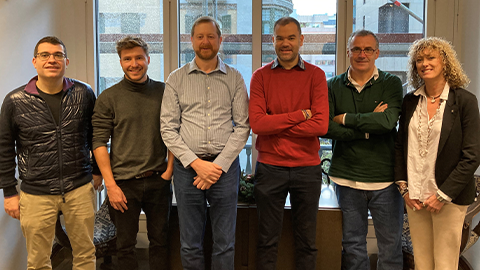A new spin-off of ICN2, UAB and CSIC will commercialise a nanotechnology-based smart ink

Distinkt sprang from years of research by Dr. Àlex Julià-López, Dr. Claudio Roscini and CSIC Prof. Daniel Ruiz-Molina, from the Nanosfun group at the ICN2, and Prof. Jordi Hernando, from the Universitat Autónoma de Barcelona. They have developed an invisible ink for anti-counterfeiting applications in official documents, banknotes, luxury goods, and more.
16/12/2022
Distinkt will bring to the market a new generation of high-security fluorescent inks based on nanotechnology developed at the ICN2 by the Nanostructured Functional Materials Group (Nanosfun), in collaboration with the Department of Chemistry of the Universitat Autónoma de Barcelona (UAB). The researchers who conceived and developed this technology –i.e., ICN2 postdoctoral researcher Dr Àlex Julià-López, ICN2 senior researcher Dr Claudio Roscini, ICN2 group leader CSIC Prof. Daniel Ruiz-Molina, and UAB Prof. Jordi Hernando— designed an ink based on a powder containing nano- and micro-particles that change colour or fluoresce when irradiated with infrared light. The ink is dynamic and adaptive, so its effect can be customised and tuned to produce various results.
The nanoparticles produced by Distinkt are easily integrated into existing inks. They are invisible to the human eye, but visible when exposed to a specific light, and provide a dynamic and unique signature: they can change colour over time or show a different effect depending on the type of light shed on them. The inks can be used to print signs, barcodes or QR codes on any material or object, from banknotes to official documents, bags and cosmetic products, with the purpose of certifying their authenticity.
"To tackle counterfeiting, governments and companies must constantly design and manufacture innovative labels or patterned paper with invisible inks, but current solutions are unfortunately easy to counterfeit once the pattern is known,” explains Luca Venza, CEO of the company. “The technology we have developed introduces a level of complexity never seen before in anti-counterfeiting tools, because thanks to nanotechnology we can achieve ink effects that are impossible to reproduce 100 %."
The Distinkt company has already established contacts with potential stakeholders interested in this technology. Among them are, on the one hand, companies that supply paper banknotes and official documents to governments, as the technology can be easily integrated into their inks at a reduced price, while offering a very high degree of security. "In ten years, our inks might be on every banknote in the world," suggests and hopes Luca Venza. On the other hand, packaging and luxury goods companies are also potential customers, since they could apply Distinkt's technology to improve their authenticity seals.